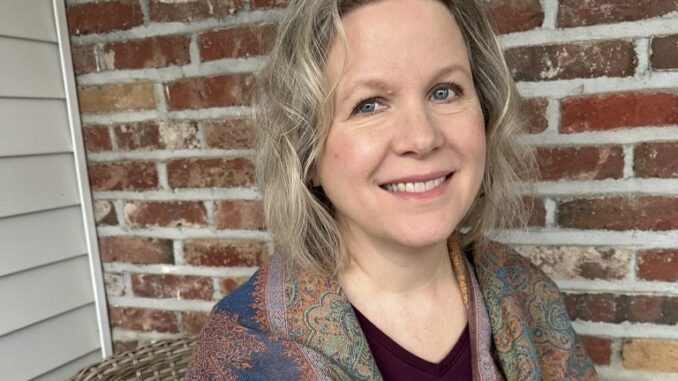
Furthering John Hartford’s legacy by releasing unheard tunes into the Fiddleverse.
This was a wide-ranging conversation with Katie Hartford Hogue talking about her experiences going through her late father John Hartford’s belongings and archives after his passing, leading to the discovery of a previously unseen collection of thousands of original fiddle tunes written in loose-leaf journals. She and her husband Eric have spearheaded the process of preserving and sharing this creative legacy through donations and two albums – “The John Hartford Fiddle Tune Project” in 2020 and “Julia Belle: John Hartford Fiddle Tune Project Vol. 2″ in February 2025. The story of these tunes and his passion for the fiddle can be found in the book, “John Hartford’s Mammoth Collection of Fiddle Tunes.”
John Hartford was a prolific composer, multi-instrumentalist, and newgrass pioneer whose musical legacy has continued to unfold and be celebrated after his death, as his family and collaborators work to bring his music to new audiences. His history of recording his own musical jams and collaborations with others on cassette tapes led to not only the fiddle project series but also Tony Trischka transcribing and recording the jams Hartford played with Earl Scruggs in the latter’s Kentucky cabin, released as “Earl’s Jams, volume one” in 2024 with a second volume to come.
Hartford made a concerted effort to document and preserve the history of music, the river, steamboats and other topics he was passionate about. His unique blend of left-brain and right-brain talents made him both a meticulous archivist/historian and a prolific, creative writer/composer.
The collaborative nature of these projects involves musicians, producers, and archivists working together to bring Hartford’s music to life. The potential impact is huge to introduce his fiddle tunes to new generations of listeners and musicians and could inspire further exploration and celebration of Hartford’s multifaceted talents.
Why was the second volume of fiddle tunes recorded by only women? In the lyrics of ‘Julia Belle,’ you hear Hartford looked at the Julia Belle Swain steamboat as piloted and crewed by women. That gave Hartford Hogue and her co-producers the idea to pitch it to talented women players like Rachel Baiman, Phoebe Hunt, Missy Raines, Ginger Boatwright, Natalie and Brittany Haas, Allison de Groot and Della Mae. All told, 48 women graced the project. “The feeling of working on an all-female project is unparalleled,” says Della Mae’s IBMA Award-winning bassist and vocalist, Vickie Vaughn. “It felt powerful and developed a real sense of togetherness and community.”
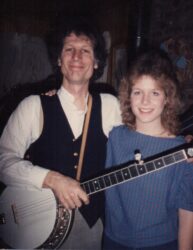
Katie Hartford Hogue was born in California when her father was pursuing a career in the movies but grew up in Tennessee after her parents split. She recalls memories from when her father would visit, reading and acting out the newspaper funny pages together, showing her how he made his line drawings, taking her on road trips to festivals and just hanging around his house with a cat named Christmas.
The conversation with Katie flowed like the riverboats her father was so enamored of steering. She shared personal anecdotes and insights about her relationship with him and the process of going through his belongings and archives. “He was a historian, a collector. He called himself a frustrated librarian. He was all about maintaining the history of music, of the river, of the things that he loved. He made sure that he kept notes and ephemera and collectibles, all these things. Every box I opened was a new discovery, and there were some really interesting things. I feel like I learned so much about him because he was only 63 when he passed.”
It’s mind-boggling to think one man could produce the over 4,000 tunes Katie Hartford Hogue found in her father’s house, the 1000 or so from his jams with Earl Scruggs and the numerous recordings throughout a 40-year career. It begs the question: what else is out there? Talking about her father’s constant creativity, his daughter offered, “If there was nothing going on in his hands, there was definitely something going on in his head.”
What did you have in mind when sorting through your father’s affairs and belongings?
Boy, that’s an hour answer right there. Obviously, grief, tremendous grief. It was about seven years between the time of dad’s passing before all the estate was settled. We were in Dallas at the time with our kids. Grew up there partly, too, and were in the process of moving back to Nashville. When we got the call, everything was settled and here’s all this stuff you need to find a place to store. Thankfully, we had a house with a finished basement that was big enough to put all that inside. It was just box after box after box.
If you can imagine, dad was a historian, a collector. He called himself a frustrated librarian. He was all about maintaining the history of music, of the river, of the things that he loved. He made sure that he kept notes and ephemera and collectibles, made sure all these things were preserved. He also was an intense creative, which means there was constantly stuff coming out of his mind and brain that he was writing down and playing and recording.
You’ve said that he was both a left brain, right brain sort of person?
Absolutely. You can imagine the amount of stuff that would fill a good-sized basement. We were walking around boxes., making walls and tunnels. The grief just kind of opened up again because it had been seven years and then all of a sudden, basically in a lot of ways, dad was back in the house. So, there’s processing, thinking through, memories, learning more about him. There is a lot we don’t know about our parents, and a lot parents don’t know about their kids. So, every box I opened was a new discovery.
I feel like I learned so much about myself because there was a lot that we had not had a chance to connect on as he was only 63 when he passed. I realized that we had similar thinking in so many areas, but the strategic window had not been there for us to be in the same place at the same time to discuss these things together. So, I am having to do it separately while going through all of this. We used to call the area where we stored his things, the vortex, because you don’t go down there unless you’ve got a few hours, and heaven help you if you open a box and start reading something.
Interesting analogy as sometimes a river has a vortex.
I am not exaggerating. As we’re going through all of this, we were thinking about how do we take care of it? Also, this is really interesting and I want to know more. Some of it I had no idea. It was this big undertaking. For a few years, we donated the riverboat material, 93 boxes of ephemera, photographs, maps, his journeys as a pilot, to the Herman T. Pott National Inland Waterways Library at the Mercantile in St. Louis.
That was a whole other side of your father that most people wouldn’t know.
He made cassette tapes of jams at the house where he was trying to capture it all because of the historian side. There were easily thousands of cassette tapes, four to five thousand I believe, some of which had Earl (Scruggs)and Bill (Monroe) and Roy Huskey, and then the old fiddlers, Frazier Moss and Texas Shorty, just whoever he was with at the time he recorded. All of those went to the Center for Popular Music, and they actually received a Grammy Foundation grant to start digitizing a collection. Vanderbilt University received a lot of his books.
Did you have a method to sort through all of it?
As we’re opening boxes, I kept finding these spiral-bound notebooks with music written in them, mostly in pencil. They all have a large number written in black Sharpie in the top right corner. I started stacking them up and then talking to people. Matt Combs knew what they were and said dad had been writing fiddle music.
Nancy Blake said he’s got this huge treasure trove that needs to be preserved. It was like a Sherlock Holmes mystery. We cobbled together what he had been doing after his cancer diagnosis in the early ‘80s. He had always wanted to learn to write music notation. And when you have one of those life-changing shifts you get on it. My brother and other people helped him. He took all that was going on in his head and wrote it down. The librarian and the creative came together and once you start opening the creative font, it just keeps coming.
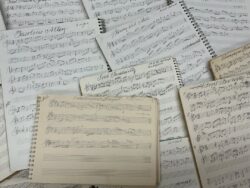
Just how many of these tunes would you estimate are in the collection?
The more that you use your mind, the more that you work that muscle, the more that comes out, and the deeper it goes, the more you learn and expand. It’s like this crystalline structure that connects within itself and becomes this big beautiful thing. These journals probably start in 1983 and go up to the very beginning of 2001, which is the year he passed. I would say there’s over 4,000 tunes in them.
I don’t know if he ever expected there to be such a magnifying glass on his journals, but to me, this massive amount of creativity, you can’t just let it sit in hopes that maybe someone will come look at it someday. I thought long and hard about it. I talked to Matt and to Greg Reish, who’s the director of the Center for Popular Music, and we decided to write a book. Matt went through all the journals, played through and tested them to find out can you even play some? Because these were tunes that came out of his head, some couldn’t actually translate on the neck of a fiddle. It would require some really intense yoga exercises to get your hands to do that. We culled out about 176 tunes that from our perspective were the cream of the crop. That’s where the book came from.
What form were they in? Melody, chords?
I don’t know that I’ve even seen any chord changes, just melody. So, there’s a lot of latitude in these tunes. They’re just these beautiful, simple melodies, and his DNA comes through on every one of them. You can hear him.
He never recorded any of these tunes?
We do have evidence of some tunes that he actually recorded. There’s a CD. As the story goes, Mark Howard, who was a producer and also a musician that worked together with dad, saw what he was doing. He said, John, I think you’ve got something here, and Dad just kind of blew it off. And so Mark went and got, I want to say it’s Jerry McCoury and there may be one other person. They put the chords around the melodies and presented dad with all of these tracks and said, now you go put the fiddle on top of it just to get him to do it. And that is the CD, “Cadillac Rag.” We refer to that like the sequel, kind of like “Star Wars.”
And then we also found this little book that looks like it was printed on a photocopier. A handful of people have one. He had a photocopier in his office where he had put together 20 tunes that actually predate the journals. I’m not completely sure where these came from. He handed out these booklets to his friends. Someone found one at Earl Scruggs’ Estate Sale. I don’t know if you’re familiar with it, but in fiddle circles, there’s a book called “Ryan’s Mammoth Collection,” and it’s a thousand fiddle tunes of just all over that Ryan collected. They’re all public domain fiddle tunes, and dad was a huge fan of that book. We said it would be really fun to call this “Hartford’s Mammoth Collection.” I was back down in the archive, and I found a thick red hardbound book and, on the spine, it had written “Hartford’s Mammoth “Collection. I don’t want to get weird about this, but there are times where I feel like he is directing some things, showing me where some things are at. In some ways I feel like we’re doing this project together.
You didn’t grow up with your dad in the house. He and your mom had split. What type of relationship did you have with him?
My parents split when I was an infant. Dad had been working on the Smothers Brothers and Glen Campbell shows out in Hollywood. I was born across the street from NBC studios in Burbank, California. My mom still has some of the cards that came with flowers and the telegrams from Tommy Smothers and Rob Reiner. Dad had just hit a point in Hollywood where everybody wanted him. He was the new thing. Someone thought he was going to be the next Dylan, and they were trying to make him into that.
At the time he was in his thirties and still quite handsome and desirable, so he dipped his toe in the water and a young family didn’t really fit into that. Mom had family back in Tennessee. Dad would come to Nashville a few times a year when he had business. He would pick my brother up and take him on the Delta Queen or one of the other riverboats. I was young so didn’t really know him, and it took us a while to get to a place where we were a little more connected. He would always bring us cool Christmas presents. One year he brought us cassette recorders and a pack of blank cassettes. This was in the mid-seventies when this was kind of new and for kids to have something like this was crazy. We spent all day, all week, just recording everything.
I have a cassette of dad and me in the kitchen at mom’s house reading the funny pages, acting out the parts. He was doing his radio announcer voice, and that was a really special thing to me. It’s like we found a place where we could bond. So that was good. When I got married, we had the reception at his house. He walked me down the aisle.

Where was this?
He had moved to Madison (Tennessee) at the yellow house on Falls Avenue. He and Marie were married then. And I can proudly say that John and Jamie Hartford and Jimmy Payne did a trio at my wedding, and it was pretty cool having all these great Nashville songwriters. He loved my kids, spending time with them. Papaw is what he liked to call himself.
You didn’t marry a musician, though?
I married a guy who was getting his MBA, and he is an economics professor. Eric remembers going over to dad’s house and just listening to Dad and Benny Martin in the living room playing together. He would just sit there and listen, and he cherishes those times. After dad passed, Eric was the one who picked up CDs and whatever merch that dad had been selling and kept up with the website. People were grieving and trying to find his music. Eric is the reason this is all happening because he was the glue that held us together while we were processing and trying to figure out what to do.
Do you still work the festival at Bill Monroe Park?
That festival ended a couple of years ago. It ran for ten years, but there is something coming up at the Bluegrass Museum in Owensboro (Kentucky). They’re doing a John Hartford Days, which is similar to the Jerry Garcia Days they had been doing. It’s two days of performances. Sam Bush is leading the music. My brother Jamie is going to be there, Jim Lauderdale, Alison Brown, The Dillards, a whole bunch of great musicians.
You are on to the second volume of tunes now, calling it “The Julia Belle.”
Julia Belle Swain was a mighty fine boat with a mighty fine captain too. This is the first line of the song. It was a boat that he spent a great deal of time on that would go from Peoria up to Starved Rock (Illinois State Park), and he was good friends with the captain, Dennis Trone. My brother would go up with him and work summers on the boat. He would steer it and then he go down and entertain the guests.

The first single is ‘Steam Powered Aereo Plane’ with Kathy Mattea taking the lead supported by Sierra Hull, Missy Raines, Alison Brown, Brittany Haas and Megan Lovell.
“Aereo-Plain” was the title of one of his albums, so I guess that’s where the combination comes from.
How were the players assembled for the second volume?
We’ve sought to not necessarily do the same thing twice in each volume. There’s a theme, but the goal of these albums is to see where the music goes instead of trying to fit it into a box. So, when we procure artists for these albums, what we’ll do is talk to someone who either knew dad, knew his music or was inspired by him. We’ll hand him a book and say, find the tunes that speak to you, and then come into the studio and put them through your filter. I’ve been co-producer on both volumes.
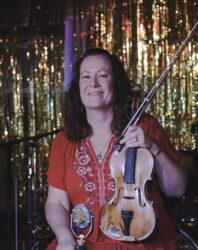
On the second volume, Sharon Gilchrist and Megan Lynch Chowning were co-producers. This one sounds quite a bit different than volume one. It’s happy, it’s joyful. It was a very organic process. Sharon Gilchrist was an early member of the Dixie Chicks who played with the Tony Rice Unit. She’s an accomplished mandolin and bass player among other things and has an incredible ear for sound and music. Megan Lynch Chowning is a national champion fiddler and one of the best music teachers that I know in this genre. She runs these camps where people can go and learn different instruments and jamming techniques. Both of these women are so soaked into this music, and they just have a sensibility about them.
As for the players, they are all women. We didn’t play that up because why should that be unusual? We want people to discover that on their own and just to be delighted with how wonderful and professional it sounds. There’s a line in the song ‘Julia Belle’ that says the Julia Belle Swain is a women’s lib boat / the first I ever knew / got girls in the pilot house, girls on deck / and a lady in the engine room. And it’s another one of those little touches that dad knew that women can do this and they’re great at it. We wanted the opportunity to make a beautiful thing and to uplift extremely talented players in the industry who do amazing things. We wanted to highlight that and just show how good these players are. But overall, the goal of this project is to do good and further Dad‘s legacy by releasing his tunes into the “fiddleverse” to be recorded and played for anyone to hear.
I’m sure you must be aware of the other project that has discovered tapes of your father with Earl Scruggs. Tony Trischka has put that all together as the “Earl Jam” album with a second volume coming out in 2025. What else could be out there?
In Tony’s project, that’s where you see the historian and librarian come out. Dad had these tapes and he knew they were precious. He knew they were important, and he wanted to make sure that they got preserved. What is it that nowadays they tell you with digital media, if you don’t have it saved in three different places, you’ve already lost it? And those cassettes weren’t digital, but he knew that if there was only one copy then it was at risk and vulnerable. That’s why he made sure that it got out, and I’m glad he did because it is absolutely in the right hands. But I will tell you, with all that we know about the archive and what we’ve donated, yes, there is more out there. Dad could keep us all busy for a long time.
What did your father find so engrossing about rivers and steamboats?
He grew up on the river in St. Louis, Missouri, so it was always with him. When he was in school in fifth grade, he had a teacher, Ruth Ferris, and there was a steamboat that was being decommissioned, The Golden Eagle. She was a big steamboat buff, who lobbied to get the pilot house brought into the schoolyard to educate the kids. Dad used to say that was a pivotal moment in his life. She introduced him to the depth that a librarian likes of information and facts in big volumes. Also, the river was outdoors and it moved and had a vibe. If you’ve ever been on a riverboat going slowly down the river and you hear that wheel go shuh-shuh-shuh, I don’t know how to describe it, but it creates an atmosphere that can draw you in. He started collecting and writing about all these different boats with different names that are constructed a little differently. When he was 15 or 16 years old, he ran away for the summer and went to work on a boat. Didn’t tell his parents. That did not go over well. He also discovered music. It became a push and pull, like, which do I do? So, he opted for the music, but then he had to dive back into the river and bring it into the music.
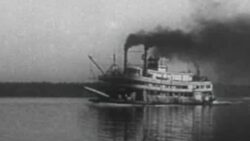
You can hear his love of the two in some songs. There’s ‘Steamboat Whistle Blues’ and ‘Skippin’ in the Mississippi Dew’ to name a couple. So many rivers. You’ve talked about doing the funny pages in the papers, but what else did you like to do with him?
I’m more of a visual person, so he showed me how he did his line drawings by looking at shadows and light to find the depth. I went on a bus with him to Tampa, Florida for a bluegrass festival. Never heard so many banjos in one place. I loved being at his house. He had a cat named Christmas that would sit on the couch with me.
In all you father’s works, what’s the one song you connect with the most?
Oh, my goodness, if I have to go with the one that pops off the top of my head, my favourite is ‘Steam-Powered Aereo Plane.’ I know that’s kind of a typical answer, but to me that song is joy. There is something about the way the music lifts, especially in that instrumental intro. that gives me goosebumps. It makes me feel, I don’t know, happy because I know he was happy when he wrote that. I think there was a peace and presence in that for him that was really special, crazy as it sounds because he wrote that song not long after our family fell apart. But that was my dad. He could always find something to be excited about.


